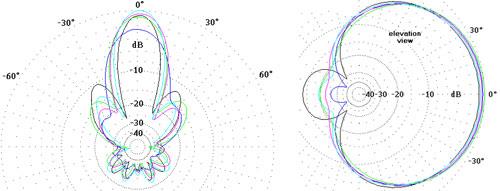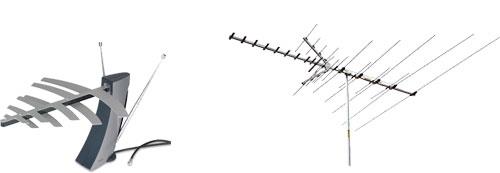If you live within a few miles of the TV transmitters serving your area, a small indoor antenna may do the job for you. If not you’ll need an outdoor antenna.
To learn what type of antenna to buy for your location, visit the TV Fool antenna selector. Enter your address, and you’ll see a list of local stations and notes about which type of antenna to use for good reception.
TV antennas may seem like relics from the last century, but plenty of viewers are using an HD antenna to eliminate or reduce their monthly cable/satellite TV bill, and enjoy a better picture from their HDTVs.
In this article, we’ll discuss the advantages of over-the-air (OTA) reception and explain how to find digital TV signals in your local TV market and in nearby cities. We’ll introduce the different types of TV antennas and tell you which ones perform best under various reception conditions. And we’ll offer tips on how to install larger attic- and roof-mount antennas.
Over-the-air HDTV signals look better than cable or satellite
The switch to digital TV broadcasting has eliminated the most annoying picture distortions — snow and ghosting — that made analog off-air reception so hit-or-miss. With digital TV signals (both standard-definition and high-definition), you’ll either see a crisp, ghost-free picture or no picture at all. Because local and syndicated programming may not be in high-definition, it’s typical for local stations to broadcast their digital signals in standard-definition during the day, then switch to full widescreen HDTV during primetime.
Even if you’ve never used an off-air antenna before, there are several good reasons to consider adding one to your other TV signal sources:
- Local digital TV broadcasts are everywhere: Although the widest selection of digital TV broadcasts are found in big cities, over 99% of U.S. TV households have access to at least one local digital station; 89% can get five or more stations. You can learn which stations in your area are providing digital broadcasts by visiting the TV Fool website listed below.
- Over-the-air digital reception provides the best picture quality: Cable and satellite providers offer tons of channels, but to do this they use data compression or other techniques that compromise picture quality, resulting in a “soft” image, distracting video artifacts (distortion), or both. Off-air antenna reception is the best way to enjoy HDTV programs at the full resolution the TV networks intended.
- Over-the-air signals are free: Aside from the costs to purchase and install an HD antenna, receiving over-the-air HDTV is free.
- Access to all your local channels: Cable and satellite TV providers may not carry all the local channels in your area, or may not offer them in high definition. Also, contract disagreements between local cable operators and local broadcasters can mean that major networks may not be available via cable TV in your area.
- Access to out-of-town channels: With the right equipment and reception conditions, some viewers may even be able to receive out-of-town channels, some of which may carry sports programs that are locally blacked out.
If you bought your HDTV anytime during the past 8 years or so, it should have a built-in tuner for receiving digital over-the-air broadcasts. If you have an older “HDTV-ready” TV that only receives analog signals, you’ll need to connect it to a separate HDTV tuner.
True HD tuners are hard to find these days; you may run across inexpensive digital TV converter boxes, but those can only provide standard-definition video, not crystal-clear high def. And if you’re currently subscribed to an HDTV package from satellite providers DIRECTV® or DISH®, your HD satellite receiver probably includes an over-the-air HD tuner.
To learn about over-the-air DVRs, read this article or shop for one.
Finding over-the-air TV signals
TV signal transmission is considered to be “line of sight.” Getting reliable DTV reception beyond the curvature of the earth (approximately 70 miles) is difficult. And if mountains or tall buildings lie between the transmitter tower(s) and your home, they can cause reception problems. So, the first step is to locate the transmitters for your local stations.
The quick, easy way to get information that’s specific to your address is to visit the TV Fool antenna selector website. Once you enter your address, you’ll see a list of local stations. Each station has a color-coded indicator showing which type of antenna is recommended for best reception. (We’ll cover the different antenna types in the next section.)
Now that you know the direction and distance of the local TV stations you can receive, let’s see which type of antenna will work best for you.
TV antenna basics
There is no one magic antenna or antenna type that will deliver excellent TV reception in every location. The main factors determining reception are the distance and direction from the TV station transmitters to your home. Other factors include the transmitter’s power and the height of its tower, the terrain between the tower and your antenna, and the size and location of any large buildings in the path of the transmission.
If you live within a few miles of the transmitter, and the signal path is relatively unobstructed, you may be able to get adequate reception using a small set-top indoor antenna. But as you move farther away, getting usable signal strength becomes trickier. This is where careful antenna selection and installation become essential.
The information below will help you zero in on the type(s) of antenna that should work best for you. Keep in mind that even in the same neighborhood reception conditions often vary from house to house. For that reason, it’s best to purchase your antenna from a dealer who offers no-hassle returns with a money-back guarantee.
VHF and UHF
Like analog signals, digital TV signals can be broadcast over two different frequency ranges: VHF (Very High Frequency) and UHF (Ultra High Frequency). The VHF channel range is 2-13 — “low-band” VHF is channels 2-6; “high-band VHF is channels 7-13. The UHF channel range is 14-51. There are nearly 1,800 full-power TV stations across the country, including 1300+ UHF, around 450 high-band VHF, and fewer than 50 low-band VHF.
If some of the local stations you want to receive are below 14, you may need a VHF/UHF antenna — especially to receive channels 2-6. A station’s channel number is usually obvious, but occasionally it can be confusing because the FCC requires digital stations to embed a “reference” to their analog channel so viewers won’t have to memorize a whole new set of channel numbers. So, your TV might identify a digital station as being in the VHF range when it’s actually in the UHF range. For example, Richmond, Virginia’s CBS station is known as “Channel 6,” but its true digital channel is 25.
What is the difference between UHF and VHF antennas? Mainly size. Antenna elements are based on the size of the waves they’re designed to receive, and VHF frequencies are lower so the waves are longer, requiring a larger antenna surface to receive them. It’s possible to build a much more elaborate UHF antenna with more elements for stronger reception while keeping the antenna size physically manageable.
Uni-directional vs. multi-directional TV antennas
Antennas described as “uni-directional” or sometimes just “directional” are designed to receive signals from one direction. “Multi-directional” or “omni-directional” antennas are able to receive signals from all directions.

The illustration on the left shows the typical narrow, focused reception pattern of a uni-directional antenna; the pattern on the right shows the broader pattern of a multi-directional antenna. Images from hdtvprimer.com
Directional antennas are able to pull in signals from greater distances, and because they “see” in only one direction they are resistant to noise and “multipath distortion” (a problem created when an antenna receives reflections of the desired signal). Because multi-directional antennas “see” in many directions they are more likely to pick up noise, interference, and multipath distortion.
If you used the tools on the previous page to locate your desired stations, you should have an accurate picture of their direction in relation to your home. If all of those stations are transmitting from an area covering a range of 20° or less, you can probably receive them using a uni-directional antenna. If the transmitters are positioned more than 20° apart, try a multi-directional antenna. As an alternative to a multi-directional antenna, you might consider combining a uni-directional antenna with a rotor, which lets you remotely rotate the antenna to pick up stations in multiple directions.
Indoor vs. outdoor antennas

Two basic antenna types. On the left is an indoor antenna with compact receiving elements less than 12 inches long. On the right is a large outdoor roof-mount model measuring 8 feet.
Indoor antennas are generally small, designed to be placed on or near your TV. Outdoor antennas tend to be significantly larger and are intended for roof- or attic-mounting. In general, the larger an antenna’s surface area is, the stronger the signal it will provide. The relative strength of the signal an antenna can deliver to a tuner is referred to as “gain” and is measured in decibels (dB). The higher the dB rating, the greater the gain. [Shop for long-range antennas]
Nearly all outdoor antennas perform better than even the best indoor antennas. Along with their size disadvantage, indoor antennas have a height disadvantage, and are adversely affected by the walls of a house and even by movement of people in the room. Other sources of household interference include fluorescent lights, computers and cordless phones.
Amplified vs. non-amplified antennas
One way to help antennas overcome size or height disadvantages, or otherwise enhance signal gain, is through the use of electronic amplification. The amplifier can be built in as it is in many indoor antennas, or it can be a separate device that installs in-line between the antenna and TV. An amplifier that installs on an outdoor antenna or mast is often called a preamplifier or “preamp.” Most experts recommend only using an amplifier if you need to. The potential drawbacks of amplifiers are that they amplify noise along with the signal, and they can be overdriven by strong signals, which can make reception worse.
Other good antenna info resources
If you know of any neighbors who are using an HD antenna, find out what type/model it is and how well it performs. You could also try calling local TV stations with your antenna questions. It’s definitely in their interest to help their viewers improve reception.
The AVS Forum’s local HDTV message boards are also an excellent source for info on digital TV reception; they’re loaded with great suggestions and solutions to particular reception problems in locations ranging from big cities to small towns and rural communities.
Whether you’re considering installing an antenna yourself or having one professionally installed, the next section offers basic tips on roof- and attic-mounting, and cabling.

